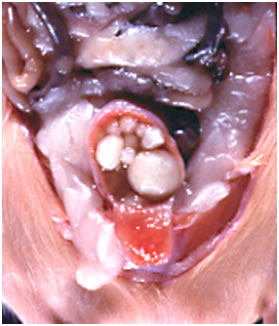Etiology: Uroliths occur both in the renal pelvis and the urinary bladder. Diet and hormones may contribute to their development.
Incidence: The incidence is uncommon. Male rats may be more prone to development of uroliths than females.
Clinical Signs: Clinical signs may be absent but obstruction within the pelvis may cause hydronephrosis. Occlusion of the neck of the bladder will cause acute dilatation of the urinary bladder, uremia and death [4].
Diagnosis: Diagnosis is made by gross examination and confirmed by histopathology.

4. Magnusson, G. and C.H. Ramsay, Urolithiasis in the rat. Lab Anim, 1971. 5(2): p. 153-62.